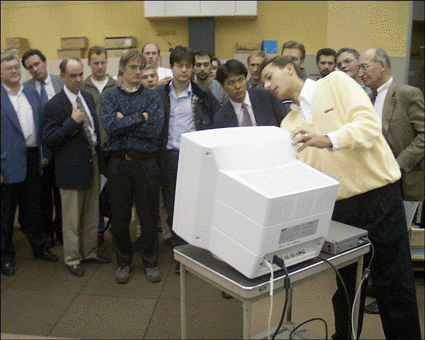


Joe Nordman from Genroco explaining the working of a GSN-ST High speed Storage Area for an international and CERN public.
Engineers at CERN have helped to build the world's fastest computer network! The Gigabyte System Network (GSN) was built during a workshop organised by CERN, in collaboration with the High Performance Networking Forum. This is only the second time that a GSN has been demonstrated in Europe, and it is the largest GSN to be built anywhere. Delegates from around the world came to see the new standard being demonstrated at the Telecom99 exhibition in Geneva.
GSN is a new type of network, which allows data to be transferred between computers at speeds of up to 800 Mbytes/sec
that's 800 000 000 characters, or almost a full length feature film, every second! This makes it the fastest operational network standard today - eight times faster than any previous type of network. In comparison, a standard modem for Internet connections carries 5600 bytes/sec, while a normal Ethernet network connection carries around 1 Mbyte/sec. CERN engineers have helped to create the GSN standard, and in particular developed a bridge to connect GSN to the increasingly popular Gigabit Ethernet architecture, as a joint project with Genroco Inc.
The CERN network uses a new network protocol called Scheduled Transfer (ST). ST allows data to be transferred from one system to another with minimal interference from the host operating system, giving very fast response times. It runs over conventional networks such as Gigabit Ethernet and HIPPI, as well as over GSN. Via these networks, ST also allows computers direct access to different storage devices such as disks and tapes. CERN's is the first demonstration of a GSN connecting multiple networks.
The combination of GSN and ST will enable high performance computing, networking and storage facilities. These are essential to handle the massive amounts of data that High-Energy Physics accelerators such as the Large Hadron Collider (LHC) being built at CERN will generate. Other potential uses include the mining of very large databases, graphics intensive computing such as in the cinema and video industries, and applications for Internet Service Providers that have to handle increasing quantities of data, generated for example by 'TV on Demand' and 'Web TV'.
It is fitting that CERN, as the birth place of the World Wide Web, is still at the forefront of network development, contributing to innovative and creative solutions for our ever increasing computing needs.
For more information about the GSN workshop:
http://www.cern.ch/HSI/hippi/hug/demo99/Demo99.html
For more information about GSN and ST:
http://www.cern.ch/HSI/gsn/gsnhome.htm